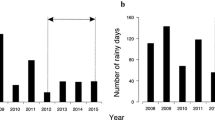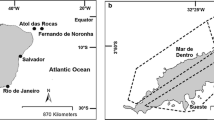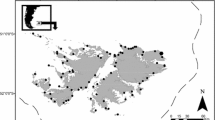Abstract
Surveys of juvenile hawksbills around Buck Island Reef National Monument, US Virgin Islands from 1994 to 1999 revealed distributional patterns and resulted in a total of 75 individual hawksbill captures from all years; turtles ranged from 23.2 to 77.7 cm curved carapace length (CCL; mean 42.1 ± 12.3 cm SD). Juveniles concentrated where Zoanthid cover was highest. Length of time between recaptures, or presumed minimum site residency, ranged from 59 to 1,396 days (mean 620.8 ± 402.4 days SD). Growth rates for 23 juveniles ranged from 0.0 to 9.5 cm year−1 (mean 4.1 ± 2.4 cm year−1SD). Annual mean growth rates were non-monotonic, with the largest mean growth rate occurring in the 30–39 cm CCL size class. Gastric lavages indicated that Zoanthids were the primary food source for hawksbills. These results contribute to our understanding of juvenile hawksbill ecology and serve as a baseline for future studies or inventories of hawksbills in the Caribbean.







Similar content being viewed by others
References
Anderson MH, Lund D, Gladfelter E, Davis M (1985) Ecological community type maps and biological community descriptions for Buck Island Reef National Monument and proposed marine sites in the British Virgin Islands. In: Virgin Islands Resource management cooperative biosphere reserve research report 4. National park service technical report: 214–229
Bass AL, Good DA, Bjorndal KA, Richardson JI, Hillis Z-M, Horrocks JA, Bowen BW (1996) Testing models of female reproductive migratory behaviour and population structure in the Caribbean hawksbill turtle, Eretmochelys imbricata, with mtDNA sequences. Mol Ecol 5:321–328
Bell I, Pike DA (2012) Somatic growth rates of hawkbsill turtles Eretmochelys imbricata in a northern great barrier reef foraging area. Mar Ecol Prog Ser 446:275–283
Berube MD, Dunbar SG, Rützler K, Hayes WK (2012) Homes range and foraging ecology of juvenile hawksbill sea turtles (Eretmochelys imbricata) on inshore reefs of Honduras. Chelonian Conserv Biol 11(1):33–43
Bjorndal KA, Bolten AB (1988) Growth rates of immature green turtles, Chelonia mydas, on feeding grounds in the southern Bahamas. Copeia 3:555–564
Bjorndal KA, Bolten AB (2010) Hawksbill sea turtles in seagrass pastures: success in a peripheral habitat. Mar Biol 157:135–145
Bjorndal KA, Bolten AB, Chaloupka MY (2000) Green turtle somatic growth model: evidence for density dependence. Ecol Appl 10(1):269–282
Blumenthal JM, Austin TJ, Bell CDL, Bothwell JB, Broderick AC, Ebanks-Petrie G, Gibb JA, Luke KE, Olynik JR, Orr MF, Solomon JL, Godley BJ (2009a) Ecology of hawksbill turtles, Eretmochelys imbricata, on a western Caribbean foraging ground. Chelonian Conserv Biol 8(1):1–10
Blumenthal JM, Austin TJ, Bothwell JB, Broderick AC, Ebanks-Petrie G, Olynik JR, Orr MF, Solomon JL, Witt MJ, Godley BJ (2009b) Diving behavior and movements of juvenile hawksbill turtles Eretmochelys imbricata on a Caribbean coral reef. Coral Reefs 28:55–65
Boulon RH (1994) Growth rates of wild juvenile hawksbill turtles, Eretmochelys imbricata, in St. Thomas. United States Virgin Islands. Copeia 3:811–814
Bythell JC, Gladfelter EH, Bythell M (1992) Ecological studies of Buck Island Reef National Monument. A quantitative assessment of selected components of the coral reef ecosystem and establishment of long-term monitoring sites. Part II. US National Park Service, Cruz Bay, St. John, US Virgin Islands, St. Croix, p 72
Bythell JC, Bythell M, Gladfelter EH (1993) Initial results of a long-term coral-reef monitoring program—impact of hurricane Hugo at Buck Island Reef National Monument, St Croix, U.S. Virgin Islands. J Exp Mar Biol Ecol 172:17–18
Carr A, Hirth H, Ogren L (1966) The ecology and migrations of sea turtles, 6. The hawskbill turtle in the Caribbean Sea. Am Mus Novit 2248:1–29
Chaloupka MY, Limpus CJ (1997) Robust statistical modeling of hawksbill sea turtle growth rates (southern Great Barrier Reef). Mar Ecol Prog Ser 146:1–8
Cuevas E, Liceaga-Correa MA, Garduno-Andrade M (2007) Spatial characterization of a foraging area for immature hawksbill turtles (Eretmochelys imbricata) in Yucatan, Mexico. Amphibia-Reptilia 28:337–346
de Kroon, Hans, Anton Plaisier, Jan van Groenendael, and Hal Caswell. 1986. Elasticity: the relative contribution of demographic parameters to population growth rate. Ecology 67:1427–1431. http://dx.doi.org/10.2307/1938700
Diez CE, Van Dam RP (2002) Habitat effect on hawksbill turtle growth rates on feeding grounds at Mona and Monito Islands, Puerto Rico. Mar Ecol Prog Ser 234:301–309
Dunbar SG, Salinas L, Stevenson L (2008) In-water observations of recently released juvenile hawksbills Eretmochelys imbricata. Mar Turt Newsl 121:5–9
ESRI (2007) ArcGIS 9.3 GIS, Redlands, CA
Gaos AR, Lewison RL, Yañez IL, Wallace BP, Liles MJ, Nichols WJ, Baquero A, Hasbún CR, Vasquez M, Urteaga J, Seminoff JA (2012) Shifting the life-history paradigm: discovery of novel habitat use by hawksbill turtles. Biol Lett 8(1):54–56
Geis A, Wibbels T, Phillips B, Hillis-Starr Z, Meylan A, Meylan P, Diez C, Van Dam R (2003) Predicted sex ratio of juvenile hawksbill sea turtles inhabiting Buck Island Reef National Monument, US Virgin Islands. J Herpetol 37:400–404
Gladfelter WB (1982) White-band disease in Acropora palmata: implications for the structure and growth of shallow reefs. Bull Mar Sci 32(2):639–643
Gladfelter WB, Gladfelter EH, Monahan RK, Ogden JC, Dill RF (1977) Environmental studies of Buck Island Reef National Monument, St. Croix, VI. West Indies Laboratory, St. Croix, USVI. 136 pp
Heppell SS, Crowder LB, Crouse DT, Epperly SP, Frazer NB (2003) Population models for Atlantic loggerheads: past, present, and future. In: Bolten AB, Witherington BE (eds) Loggerhead sea turtles. Smithsonian Institution Press, Washington, pp 255–273
Kendall WL, Bjorkland R (2001) Using open robust design models to estimate temporary emigration from capture—recapture data. Biometrics 57:1113–1122
Krueger BH, Chaloupka MY, Leighton PA, Dunn JA, Horrocks JA (2011) Somatic growth rates for a hawksbill turtle population in coral reef habitat around Barbados. Mar Ecol Prog Ser 432:269–276
Kubis S, Chaloupka M, Ehrhart L, Bresete M (2009) Growth rates of juvenile green turtles Chelonia mydas from three ecologically distinct foraging habitats along the east central coast of Florida, USA. Mar Ecol Prog Ser 389:257–269. doi:10.3354/meps08206
Leon YM, Bjorndal KA (2002) Selective feeding in the hawksbill turtle, an important predator in coral reef ecosystems. Mar Ecol Prog Ser 245:249–258
Leon YM, Diez CE (1999) Population structure of hawksbill turtles on a foraging ground in the Dominican Republic. Chelonian Conserv Biol 3(2):230–236
Limpus CJ (1994) The hawksbill turtle, Eretmochelys imbricate, in Queensland: population structure within a southern Great Barrier Reef feeding ground. Wildl Res 19(4):489–505
Mendonça MT (1983) Movements and feeding ecology of immature green turtles (Chelonia mydas) in a Florida lagoon. Copeia 1983(4):1013–1023
Meylan A (1988) Spongivory in hawksbill turtles: a diet of glass. Science 239:393–395
Meylan PA, Meylan AB, Gray JA (2011) The ecology and migrations of sea turtles. 8. Tests of the developmental habitat hypothesis. B Am Mus Nat Hist. Number 357. 70
Mortimer JA, Donnelly M (IUCN SSC Marine Turtle Specialist Group) (2008) Eretmochelys imbricata. In: IUCN 2012. IUCN Red List of Threatened Species. Version 2012.1. www.iucnredlist.org. Downloaded on 30 July 2012
Mortimer JA, Collie J, Jupiter T, Chapman R, Liljevik A, Betsy B (2003) Growth rates of immature hawksbills (Eretmochelys imbricata) at Aldabra Atoll, Seychelles (Western Indian Ocean). In: Seminoff JA (ed) Proceedings of the 22nd annual symposium on sea turtle biology and conservation. NOAA Technical Memorandum NMFS-SEFSC-503. US Department of Commerce, Miami, FL, pp 247–248
National Marine Fisheries Service (NMFS) and United States fish and wildlife service (USFWS) (1993) Recovery plan for hawksbill turtles in the U.S. Caribbean Sea, Atlantic Ocean, and Gulf of Mexico. St. Petersburg, FL
NMFS & USFWS (1998) Recovery plan for U.S. Pacific populations of the hawksbill turtle (Eretmochelys imbricata). NMFS Silver Spring, MD
Pawlik JR, Chanas B, Toonen RJ, Fenical W (1995) Defenses of Caribbean sponges against predatory reef fish. I. Chemical deterrency. Mar Ecol Prog Ser 127:183–194
Pemberton RA Jr (2001) The Habitat Utilization of Hawksbill Sea Turtles Eretmochelys imbricata at Buck Island Reef National Monument St. Croix U.S. Virgin Islands, MS Thesis, Virginia Institute of Marine Science, Gloucester Point, VA 111 pp
Rincon-Diaz MP, Diez CE, Van Dam RP, Sabat AM (2011) Foraging selectivity of the hawksbill sea turtle (Eretmochelys imbricata) in the Culebra Archipelago, Puerto Rico. J Herpetol 45:277–282
Sánchez-Rodríguez J, Cruz-Vázquez K (2006) Isolation and biological characterization of neurotoxic compounds from the sea anemone Lebrunia danae (Duchassaing and Michelotti 1860). Arch Toxicol 80:436–441
SAS (1997) SAS version 6. SAS Institute Inc, Cary
Scales KL, Lewis JA, Lewis JP, Castellanos D, Godley BJ, Graham RT (2011) Insights into habitat utilisation of the hawksbill turtle, Eretmochelys imbricata (Linnaeus 1766), using acoustic telemetry. J Exp Mar Biol Ecol 407:122–129
Stampar SN, da Silva PF, Luiz OJ Jr (2007) Predation on the Zoanthid Palythoa caribaerum (Anthozoa, Cnidaria) by a hawksbill turtle (Eretmochelys imbricata) in southeastern Brazil. Mar Turtle Newsl 117:3–5
Swearington DC, Pawlik JR (1998) Variability in the chemical defense of the sponge Chondrilla nucula against predatory reef fishes. Mar Biol 131:619–627
Van Dam RP, Diez CE (1997) Diving behavior of immature hawksbill turtles (Eretmochelys imbricata) in a Caribbean reef habitat. Coral Reefs 16:133–138
Van Dam RP, Diez CE (1998) Home range of immature hawksbill turtles (Eretmochelys imbricata (Linnaeus)) at two Caribbean islands. J Exp Mar Biol Ecol 220:15–24
Velez-Zuazo X, Ramos WD, Van Dam RP, Diez CE, Abreu-Groboiss A, McMillan WO (2008) Dispersal, recruitment and migratory behaviour in a hawksbill sea turtle aggregation. Mol Ecol 17:839–853
Witzell WN (1983) Synopsis of biological data on the hawksbill turtle Eretmochelys imbricata Linnaeus, 1766). FAO Fisheries Synopsis 137:1–78
Acknowledgments
Fieldwork was permitted by NPS under the DPNR territorial permit (years 1994–1999) and only within Federal waters. National Park accession numbers from 1998 to 2000: BUIS-00037 to BUIS-00058; catalog number BUIS 3415. Funding for this work was provided by the National Park Service, and the USGS Priority Ecosystem Science Program. Any use of trade, product, or firm names is for descriptive purposes only and does not imply endorsement by the US Government.
Author information
Authors and Affiliations
Corresponding author
Additional information
Communicated by R. Lewison.
CNTS is contracted to U.S. Geological Survey, Southeast Ecological Science Center, Davie, FL, USA.
Rights and permissions
About this article
Cite this article
Hart, K.M., Sartain, A.R., Hillis-Starr, ZM. et al. Ecology of juvenile hawksbills (Eretmochelys imbricata) at Buck Island Reef National Monument, US Virgin Islands. Mar Biol 160, 2567–2580 (2013). https://doi.org/10.1007/s00227-013-2249-x
Received:
Accepted:
Published:
Issue Date:
DOI: https://doi.org/10.1007/s00227-013-2249-x




